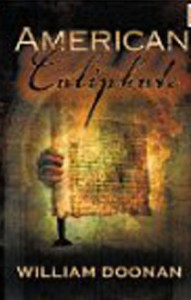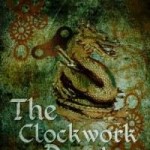 Our guest post today comes from Lesley Diehl, a retired professor of psychology. She splits her time between upstate New York where she and her husband are renovating an 1872, ghost-inhabited cottage, and old Florida where spurs still jingle in the post office and gators make golf a contact sport. Today, she asks the question, Bury that manuscript in a drawer or rewrite it?
Our guest post today comes from Lesley Diehl, a retired professor of psychology. She splits her time between upstate New York where she and her husband are renovating an 1872, ghost-inhabited cottage, and old Florida where spurs still jingle in the post office and gators make golf a contact sport. Today, she asks the question, Bury that manuscript in a drawer or rewrite it?
The Self-publishing Jitters
Here’s the dilemma. Open up the file on that old manuscript you never got published, read it, and send it to the trash bin, or at least, file it under “yuk!” and forget it. Or you could read it through, realize how bad it really was, heave a sigh of relief that it never was published, saving you the embarrassment of all those one star reviews, and then… Read it again. Maybe the characters were interesting, but need more depth. Their motivation for trying to solve the crime may be weak. Perhaps the plot is thinly drawn, too simplistic or too convoluted for a reader to follow. The pacing may be too slow and more tension is required to keep the reader’s interest. You could rework it. Naw! But before you press the delete button, reconsider. I did.
Here’s my confession. I took the very first manuscript I wrote, and began revising it several years ago, using the time between writing others to work on the old one. I had several readers take a look at it, I revised again, and just this month I published it. And, yes, I wake up in the middle of the night wondering if I should locate the “unpublish” button and press it. Of course I’m nervous about this work. It was my first attempt at a mystery. I have a blog tour for it coming up in May. Until then I probably won’t know how readers will receive it. I’m taking a chance, and I know it, and I’m terrified.
Write what you know is always sage advice, so I did just that. This book is taken from my life before writing, when I was a faculty member and administrator at several colleges and universities. I spent over 25 years in academie, so it’s familiar to me. I loved being in the classroom, and I loved doing collaborative research with my students. But like any other place trying to survive in a world where resources are becoming scarce, institutions of higher learning are competitive environments where faulty vie for promotions and they don’t trust administrators any more than administrators trust them. Having been on both sides of the fence, I know how difficult life on campus can be.
Given the atmosphere of the college campus, is it any wonder that, in my first attempt at fiction I killed off a college president and then took down one of the faculty? To my credit, when I reworked the manuscript I reduced it from over 100,000 words to around 70,000. Most of those words were located in long convoluted sentences that described in too much detail the inner life of faculty and staff. I left students alone. They suffer enough trying to pass their courses and pay their tuition. Not that students are angels, but later, I said to myself, and that’s just what I did. The sequel to the book has my protagonist take on bad frat boys.
Here’s a short description of Murder Is Academic:
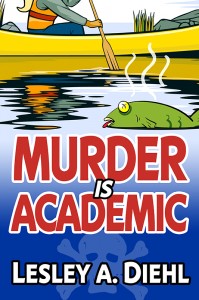 Laura Murphy, psychology professor, thinks there’s nothing she likes better than coffee and donuts on a summer morning until she says yes to dinner with a Canadian biker and finds herself and her date suspects in the murder of her college’s president. Laura’s friend, the detective assigned the case, asks her to help him find out who on the small upstate New York college campus may be a killer. The murder appears to be wrapped up in some unsavory happenings on the lake where Laura lives. A fish kill and raw sewage seeping into the water along with the apparent drowning suicide of a faculty member complicate the hunt for the killer. And then things become personal. The killer makes a threatening phone call to Laura. With a tornado bearing down on the area and the killer intent upon silencing her, Laura’s sleuthing work may come too late to save her and her biker from a watery grave.
Laura Murphy, psychology professor, thinks there’s nothing she likes better than coffee and donuts on a summer morning until she says yes to dinner with a Canadian biker and finds herself and her date suspects in the murder of her college’s president. Laura’s friend, the detective assigned the case, asks her to help him find out who on the small upstate New York college campus may be a killer. The murder appears to be wrapped up in some unsavory happenings on the lake where Laura lives. A fish kill and raw sewage seeping into the water along with the apparent drowning suicide of a faculty member complicate the hunt for the killer. And then things become personal. The killer makes a threatening phone call to Laura. With a tornado bearing down on the area and the killer intent upon silencing her, Laura’s sleuthing work may come too late to save her and her biker from a watery grave.
So, as I bite my nails and lose sleep over how this work will fare, I’d sure like to hear if others have revamped old work and then published it. Were you as anxious about doing it as I was? And how did it turn out for you?
Jim: Thanks, Lesley, for sharing your feelings on this. I hope you get some good comments on what to do with those old manuscripts.
Lesley has three mystery series in print: her microbrewing series, the rural Florida series, and the Eve Appel series. I can vouch for her books. You can buy them at:
http://www.amazon.com/dp/B00JCV6XG8
http://store.untreedreads.com/Books/UTR9781611879414

 competing as a gymnast at the 1984 New Orleans World’s Fair, to working in many positions in theatrical productions, including performing as a Can Can girl. After she received her JD from Loyola University, she joined the Orleans Parish District Attorney’s office. She quit the D.A.’s office when she had her first child, and is now an appellate public defender. Sounds interesting to me.
competing as a gymnast at the 1984 New Orleans World’s Fair, to working in many positions in theatrical productions, including performing as a Can Can girl. After she received her JD from Loyola University, she joined the Orleans Parish District Attorney’s office. She quit the D.A.’s office when she had her first child, and is now an appellate public defender. Sounds interesting to me.
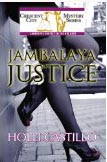
 r of a number of excellent mysteries.William has spent the last fourteen years helping students explore the structures and functions of past and contemporary cultures. As an active field archaeologist, he spent summers on Peru’s north coast excavating pyramids, mummies, and strange little mud walls. I’ll give you some links to his work below, but first, let’s hear about …
r of a number of excellent mysteries.William has spent the last fourteen years helping students explore the structures and functions of past and contemporary cultures. As an active field archaeologist, he spent summers on Peru’s north coast excavating pyramids, mummies, and strange little mud walls. I’ll give you some links to his work below, but first, let’s hear about …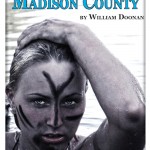 d for many days, but I’m pleased with the result.
d for many days, but I’m pleased with the result. 